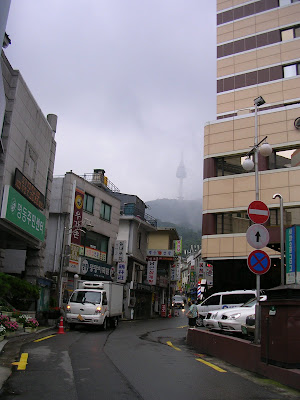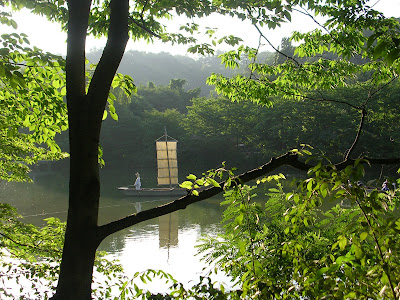 During the Kim & Lee post-intensive-classes week off, Taylor and I decided to go to Jeju Island for an indetermined length of time. After days of fruitless attempts at planning flights and visas to China or Japan, and due to the fact neither of us had much money, we decided on Jeju because it's easy and cheap and part of the Republic of Korea, so visas and a multiple entry stamp for my passport weren't needed.
During the Kim & Lee post-intensive-classes week off, Taylor and I decided to go to Jeju Island for an indetermined length of time. After days of fruitless attempts at planning flights and visas to China or Japan, and due to the fact neither of us had much money, we decided on Jeju because it's easy and cheap and part of the Republic of Korea, so visas and a multiple entry stamp for my passport weren't needed.We took the train down to Mokpo, a port city at the bottom of South Korea, and we made our way to the ferry terminal where we were unfortunate enough to have missed the ferry by two minutes. So we ended up staying a night in Mokpo, but it was pretty cool because there was a sizeable hill littered with pagodas and other tourist-friendly structures, and the view was awesome at the top (see above), so not too bad of a day. Mokpo itself seemed to consist of nothing but motels, fish markets and places to buy fishing equipment. The fish market smelled terrific. Additionally, there was also a very lewd poster for a questionable event that clearly involved homoerotic dancing and plenty of alcohol, and what made it even more sinister was the fact that it was presented entirely in Hangul, so really there was no telling what you were getting yourself into. It seemed completely out of place for a simple port city, but I suppose they have to get their kicks somehow after a hard day of gutting squid. Mokpo photos below:









 We took a giant ferry the next day to Jeju Island, which took about five hours to get there. It was similar to a British Columbia ferry, except it had several mini karaoke rooms in it (aka Noraebang) that these old Korean codgers were just going nuts at inside. It was really entertaining to walk slowly past the rooms and see the elderly party of drunken old men singing terrible, terrible Korean pop songs. At Jeju we went to a lava cave (which contained the largest known lava column in the world, photo below) and it had a good cave vibe to it, lots of dripping water and shiny rock walls. The hordes of Korean tourists prevented the Journey to the Centre of the Earth feel from really setting in, but it was still neat. We went on a hike the next day and also found a small temple in Jeju city which was worth a little look around. The manji symbol is quite common in Korea as a Buddhist symbol, but they make special effort to use left-facing swastikas to differentiate them from the Gestapo. So don't be alarmed when you see the giant Nazi drum in the next few photos:
We took a giant ferry the next day to Jeju Island, which took about five hours to get there. It was similar to a British Columbia ferry, except it had several mini karaoke rooms in it (aka Noraebang) that these old Korean codgers were just going nuts at inside. It was really entertaining to walk slowly past the rooms and see the elderly party of drunken old men singing terrible, terrible Korean pop songs. At Jeju we went to a lava cave (which contained the largest known lava column in the world, photo below) and it had a good cave vibe to it, lots of dripping water and shiny rock walls. The hordes of Korean tourists prevented the Journey to the Centre of the Earth feel from really setting in, but it was still neat. We went on a hike the next day and also found a small temple in Jeju city which was worth a little look around. The manji symbol is quite common in Korea as a Buddhist symbol, but they make special effort to use left-facing swastikas to differentiate them from the Gestapo. So don't be alarmed when you see the giant Nazi drum in the next few photos:









I was REALLY tempted to ring the enormous bell but I figured that would be pretty disrespectful. I bet it would have been really loud though.















